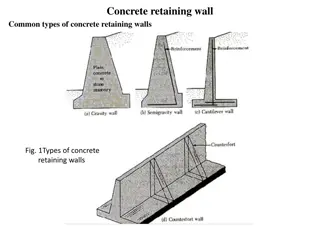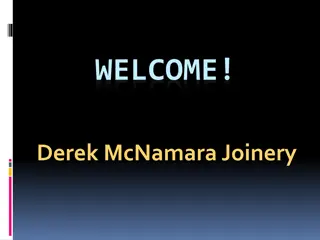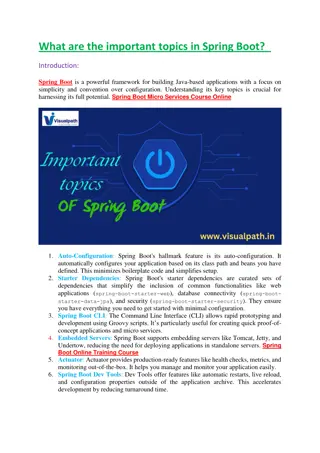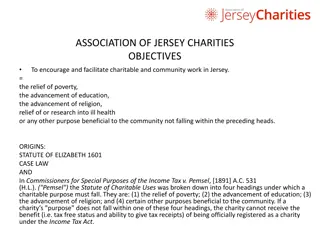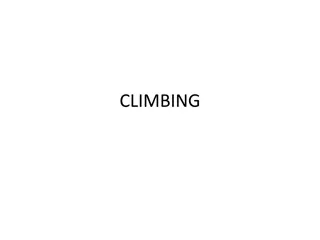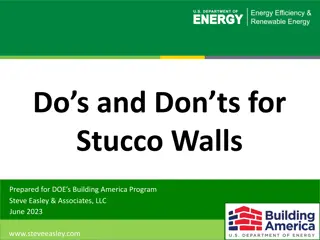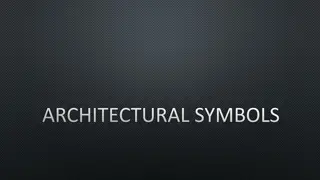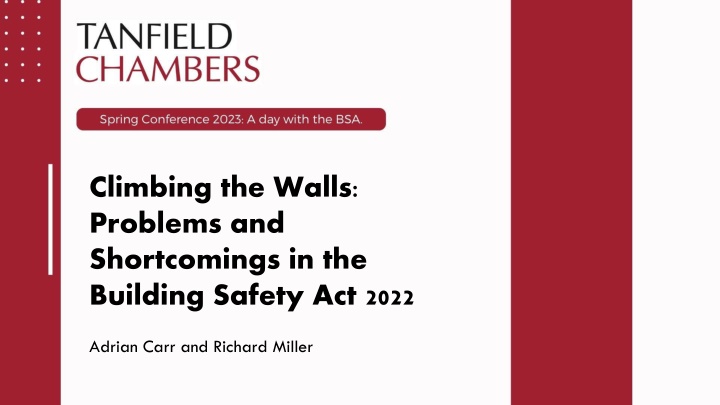
Problems in Building Safety Act 2022: Climbing the Walls
Explore the challenges and shortcomings in the Building Safety Act 2022 as highlighted by Adrian Carr and Richard Miller. Discuss the legislative aims, qualifying leases, and the significance of conditions C and D. Learn why February 14, 2022, is a crucial date in establishing fixed liabilities and preventing manipulation of leaseholder protections provisions.
Uploaded on | 0 Views
Download Presentation

Please find below an Image/Link to download the presentation.
The content on the website is provided AS IS for your information and personal use only. It may not be sold, licensed, or shared on other websites without obtaining consent from the author. If you encounter any issues during the download, it is possible that the publisher has removed the file from their server.
You are allowed to download the files provided on this website for personal or commercial use, subject to the condition that they are used lawfully. All files are the property of their respective owners.
The content on the website is provided AS IS for your information and personal use only. It may not be sold, licensed, or shared on other websites without obtaining consent from the author.
E N D
Presentation Transcript
Climbing the Walls: Problems and Shortcomings in the Building Safety Act 2022 Adrian Carr and Richard Miller
Legislative Aims and Principles (Dis)qualifying Leases Condition C: 14 February 2022 Condition D: Only or Principal Home Relevant Defects Remediation Contribution Orders A Proliferation of Certification
Section 119(2) Condition C: Lease Granted before 14 February 2022 Condition D: Only or Principal Home Evidential Challenges
Section 119(2) of the Building Safety Act 2022 A lease is a "qualifying lease" if (a) it is a long lease of a single dwelling in a relevant building, (b) the tenant under the lease is liable to pay a service charge, (c) the lease was granted before 14 February 2022 [ Condition C ], and (d) at the beginning of 14 February 2022 ("the qualifying time") (i) the dwelling was a relevant tenant's only or principal home, (ii) a relevant tenant did not own any other dwelling in the United Kingdom, or (iii) a relevant tenant owned no more than two dwellings in the United Kingdom apart from their interest under the lease [ Condition D ]
Why 14 February 2022? Explanatory Notes, 947: establishing a time of fixed and immutable liabilities is important to give certainty to all parties who will be affected by the leaseholder protections provisions and to the housing market Explanatory Notes, 948: that was the date on which the leaseholder protections provisions were first tabled and as such the point at which the provisions first become public knowledge Unlike with most Acts of Parliament, this leaves no time between publication of the amendments and the provisions becoming law Essentially an exercise in preventing unscrupulous landlords from destroying the purpose of the legislation: the choice of qualifying time means that the provisions could not be manipulated or preemptively avoided
The New Lease under Part II of the Leasehold Reform, Housing and Urban Development Act 1993 The grant of a new lease operates by way of surrender and regrant. Section 56 states: (1) Where a qualifying tenant of a flat has under this Chapter a right to acquire a new lease of the flat and gives notice of his claim in accordance with section 42, then the tenant shall be bound to accept (a) in substitution for the existing lease a new lease of the flat at a peppercorn rent for a term expiring 90 years after the term date of the existing lease Thus a new lease granted after 14 February 2022 will not benefit from the protections in Part 5 and Schedule 8 of the Building Safety Act 2022
The Governments Response Guidance: Qualifying Date, Qualifying Lease and Extent, last updated 21 April 2023: We are looking to legislate to resolve this issue as soon as Parliamentary time allows. In the meantime, before seeking a new extended or varied lease, leaseholders should seek legal advice and seek to come to agreements with landlords to apply the same protections as contractual terms As to which: 1. Why would a landlord agree? 2. How can a leaseholder be certain that any agreement would apply the same protections ? 3. Can parties contract into the Building Safety Act 2022? 4. Would such an agreement be assignable? If so, would lenders be prepared to lend on the same?
Condition D: At the Beginning of 14 February 2022 The Dwelling Was a Relevant Tenant s Only or Principal Home
Similar Provisions Leasehold Reform Act 1967, Section 1(ZB): only or main residence Housing Act 1985, section 81: only or principal home Housing Act 1988, section 1(1)(b): only or principal home Case law on these and other similar provisions are likely to assist
The Significance of the Qualifying Time The status of a lease as qualifying or not qualifying is determined by the qualities of the lessee as at 14 February 2022. The Explanatory Notes recognise this: Example 5 A person owns a flat which has a qualifying lease. The lease is qualifying because the flat was their principal home on 14 February 2022. They sell the flat on. The leaseholder protections automatically transfer to the future buyer of the flat. The protections transfer irrespective of the identity of the buyer, because the status of the lease as qualifying was determined with respect to the position on 14 February 2022 Example 6 A person owns a flat which has a non-qualifying lease because on 14 February 2022 they owned nine flats in total in England. They sell it on to a buyer who intends to live in the flat. Even though the flat will be the buyer's principal home, the lease remains non-qualifying because on 14 February 2022 it was not a qualifying lease
Consequences The market for leases will be skewed: those which qualify will be more valuable than those which do not Purchasers, conveyancers, and lenders will be concerned to know about a seller s property portfolio and living arrangements as at 14 February 2022 Unlike disputes regarding quality of occupation in enfranchisement of leasehold houses and about secure and assured tenancies, the case will be determined on the status of a third party It is an obliging predecessor-in-title who would endure giving evidence in a First-Tier Tribunal application for the pure financial benefit of their successor
Evidential Problems Example Some time before 14 February 2022, an elderly man suffers a fall in his flat and is hospitalised. He has an operation and initially intends to return to his flat when he makes a full recovery. Unfortunately, due to his injury and his other ailments, it becomes apparent that he needs to move to an assisted living facility or care home. While still in hospital, and now after 14 February 2022, he and his family organise the sale of his flat to pay for the anticipated fees. The landlord obtains a qualifying lease certificate. The man moves into a care home. He dies in 2024. In 2025, the buyer brings an application under section 27A against the landlord, alleging that charges for remedying a relevant defect have been improperly included in the service charge. The landlord alleges that the lease is not a qualifying lease because the flat was not the predecessor-in-title s only or principal home on 14 February 2022. The question turns on when the predecessor-in-title demonstrated an intention never to return to the flat. He is dead and the buyer does not know the whereabouts of his family so that they can give evidence (assuming they wish to do so). How should the First-Tier Tribunal proceed?
Section 120 and Restricted Meaning of relevant defects Section 124 and Restricted Meaning of remediation contribution order Schedule 8 and a Proliferation of Certification Conclusion
TOPIC 1 Meaning of relevant defect under Section 120 (2) Relevant defect , in relation to a building, means a defect as regards the building that (a) arises as a result of anything done (or not done), or anything used (or not used), in connection with relevant works, and (b) causes a building safety risk Where the expression building safety risk is defined in subsection 120(5) as (5) building safety risk , in relation to a building, means a risk to the safety of people in or about the building arising from (a) the spread of fire, or (b) the collapse of the building or any part of it
Compare with definition of Building safety risk for the purposes of Part 4 section 62(1) of the Act: In this Part building safety risk means a risk to the safety of people in or about a building arising from any of the following occurring as regards the building (a) the spread of fire; (b) structural failure; (c) any other prescribed matter.
Explanatory Notes 957: The leaseholder protections deal only with historical building safety defects; they are backward-looking only. They are a one-off intervention designed to deal with the current serious problems with historical building safety defects in medium- and high-rise buildings. The protections afforded only apply to defects created in the 30-year period prior to commencement of the provision, so in practice between mid-1992 and mid-2022. A 30-year period has been chosen as evidence shows that this period captures all buildings affected by the relevant safety issues.
Explanatory Notes 960: Section 62 includes a power to prescribe other matters within the definition of a building safety risk. Although it is not proposed to expand that definition at this time, that power gives important flexibility for the future regime in Parts 3 and 4 of this Act should new building safety risks materialise. The leaseholder protections are backward-looking only, in the sense that they only apply to historical building safety defects. They are a one-off intervention designed to deal with current issues associated with historical defects in certain buildings and so it is not necessary to mirror a power to expand the definition of building safety risk in this section.
Application The Act contains no power to allow the meaning of the expression building safety risk in Part 5 to be broadened by future regulation. This appears to be a deliberate policy decision of Parliament. So, barring amendment of the Act itself, this means that the leaseholder protections in Part 5 will be restricted to defects causing the spread of fire or the collapse of the building. Also, the leaseholder protections in Part 5 are retrospective only and cannot be used to challenge any new building safety issues which may be discovered in the future. But will another building safety risk be identified in the future ?
TOPIC 2 Meaning of Remediation contribution order section 124(2) Remediation contribution order , in relation to a relevant building, means an order requiring a specified body corporate or partnership to make payments to a specified person, for the purpose of meeting costs incurred or to be incurred in remedying relevant defects (or specified relevant defects) relating to the relevant building.
On the face of it, the definition of what comprises an RCO is narrowly defined. RCOs are restricted to costs incurred or to be incurred in remedying relevant defects relating to the relevant building . Does section 124 restrict RCOs to the costs incurred in the rectification of the defects themselves and nothing more? For example, can the costs arising from the need to decant leaseholders during the course of the works be included in an RCO? It remains to be seen how the courts will interpret section 124(2).
TOPIC 3 A Proliferation of Certification: 1. Section 119(2) defines what is a qualifying lease for the purposes of the leaseholder protections under Part 5. 2. In brief summary, lease must be a long lease, the leaseholder must be liable to pay a service charge, the lease must have been granted before 14 February 2022 and the leaseholder must satisfy the Condition (D) requirements, i.e: a) At the beginning of 14 February 2022 the flat was the leaseholder s only or principal home; and b) The leaseholder did not own the freehold or a long lease of more than two other dwellings in the UK apart from their interest under the lease in question. 3. Paragraph 13 of Schedule 8 to provides that it is presumed the relevant lease will be a qualifying lease for the purposes of section 119 unless the landlord has taken all reasonable steps (and any prescribed steps) to obtain a qualifying lease certificate and no certificate has been provided.
Prescribed Steps under Paragraph 13(2)(a) of Schedule 8 The Building Safety (Leaseholder Protections) (Information etc.) (England) Regulations 2022/859: 1. Regulation 6(2) - Before the notification date , the landlord must give notice in writing to the leaseholder which complies with regulation 6(4), where notification date means the day which is 5 days after the day on which the landlord becomes aware that: (a) the interest in the property owned by the leaseholder is to be sold; or (b) there is a relevant defect in relation to the building (regulation 6(11)). 2. The notification date arrives only 5 days after the landlord has the relevant knowledge. In practical terms, only the most efficient landlord (and its solicitors) will be able to comply with this deadline. This of course means there is likely to be a number of arguments about whether the landlord has the requisite knowledge.
Application When will the landlord becomeaware that the leaseholder s interest in the flat is to be sold ? The regulations do not provide any assistance on this. Does the landlord becomeaware only if it has actual knowledge of an intended sale of the flat? Or will the knowledge of its managing agent suffice? At what point does the leaseholder s intention to sell the flat amount to the interest in the property owned by the leaseholder is to be sold . Would the leaseholder writing to the landlord to say that it is considering selling the flat be enough? Or does the notification date only arise where the leaseholder has a fixed and settled intention to sell? When does the landlord becomeaware that there is relevant defect in the building? Is it when its surveyor or agent discovers the defect? Or is it the date on which the surveyor or engineer prepares a report for the landlord? Or is it when the surveyor or engineer s report is received by the managing agent? Or is it when the managing agent reports the matter to the landlord?
Reasonable Steps under Paragraph 13(2)(a) of Schedule 8 1. Apart from the prescribedsteps, what reasonablesteps must the landlord take to obtain a qualifying lease certificate from the leaseholder? 2. The Act gives no guidance on what will amount to reasonablesteps . 3. Presumably all the circumstances of the case will be taken into account, but bear in mind the extraordinarily exacting standards set by the Building Safety (Leaseholder Protections) (Information etc.) (England) Regulations 2022/859: a) If the landlord has not received a reply from the leaseholder 14 days before the reply date, the landlord must send the leaseholder a reminder notice and (if the landlord has the leaseholder s telephone number) telephone the leaseholder to draw the further notice to the leaseholder s attention (regulation 6(8)); and b) The leaseholder has the right to ask for an additional 4 weeks from the original reply date fixed by landlord to reply (regulation 6(9)).
Conclusions: 1. The Act has been variously described in the legal press as car crash legislation and the worst piece of property law legislation they had seen in 50 years 2. Mortgage lenders have imposed onerous requirements on conveyancers to check whether landlord and leaseholder certificates have been accurately completed. This has imposed an unacceptably high burden on conveyancers and their insurers. 3. We have only had an opportunity to consider a few areas of difficulty caused by the drafting of the Act and the regulations made under it. 4. While conveyancers may lament the drafting of the legislation, litigators should be happy. Bad legislation breads copious litigation.
Richard Miller Adrian Carr 020 7421 5300 clerks@tanfieldchambers.co.uk www.tanfieldchambers.co.uk Disclaimer: This content is provided for information purposes only. It does not constitute legal advice and should not be relied on as such. No responsibility for the accuracy and/ or correctness of the information and commentary set out in the article, or for any consequences of relying on it, is assumed or accepted by any member of Chambers or by Chambers as a whole.


